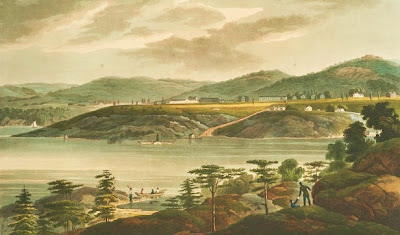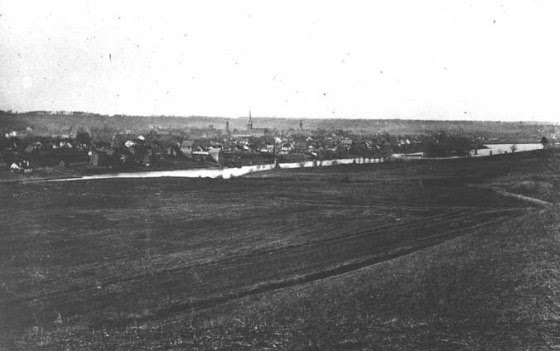c 1810 Artist Kazimierz Wojniakowski (1771-1812) Tadeusz Kosciuszko
Tadeusz Andrzej Bonawentura Kosciuszko (1746 - 1817) arrived in August of 1776, to aid the colonists in their fight against Britain. Born in Lithuania, then a part of Russian Poland, Kosciuszko sailed for America, after an extensive education in military engineering in both Poland & France. On October 18, 1776, Kosciuszko was offered the rank of Colonel of Engineers.
He set about designing a system of fortifications 3 miles downstream from Philadelphia, to protect from any possible attack by the British fleet. Kosciuszko worked on fortifications at Billingsport & Red Bank on the Delaware River until April 1777, at which time he followed his commander General Horatio Gates northward to defend the boundaries of the Canadian Frontier.
Gates asked Kosciuszko to select a site to station the army for what was felt to be a decisive confrontation with the British. Kosciuszko chose Bemis Heights along the Hudson River, fortifying it with five kilometers of earthenworks. From this vantage point the colonists defended themselves in what came to be a turning point in the Revolution, the Battle of Saratoga.
Six months later, George Washington assigned Kosciuszko to the fortification at West Point on the Hudson. West Point was Kosciuszko's greatest engineering achievement. The project took two & a half years to complete with a work force of 82 laborers, 3 masons, and a stone cutter. It would hold 2500 soldiers.
In 1778, West Point served briefly as headquarters for General Washington. For years West Point remained the largest fort in America.
While serving as Fortifications Engineer for West Point, Kosciuszko selected a secluded site for a personal garden on the ledge of a cliff below Fort Arnold. Because it was to be a private place of serenity for reading & contemplation, he never asked soldiers, civilian laborers, or prisoners of war to help him clear away the wild vegetation or to channel the mountain stream, or to cart soil down to the rock-bound garden.
Gardening & portraiture were his favorite pastimes. He devoted much of his spare time at West Point to planning his garden, constructing a fountain & waterfall, & carrying baskets full of soil to the rocky site, so that flowers might have some earth in which to grow. He discovered a spring bubbling from the rocks in the middle of the cliff, and there he fashioned a small fountain.
The garden ruins were discovered in 1802, during the first year of the Military Academy at West Point, and repaired by cadets. The spring water now rises into a marble basin. Seats overlook the fountain & ornamental shrubs dot the site which has a fine prospect of the river from the cliff.
Presidents & military officers as well as ordinary citizens have enjoyed the spot for over 200 years.
1778: Here I had the pleasure of being introduced to Colonel Thaddeus Kosciuszko, a gentleman of distinction from Poland... He had amused himself while stationed at the Point, in laying out a curious Garden in a deep valley, aboudning more in rocks than in soil. I was gratified in viewing his curious water fountain with spraying jets and cascades.--Military Journal during the American Revolutionary War, from 1775-1783; Describing Interesting Events and Transactions of This Period, with Numerous Facts and Anecdotes. Boston: Cottons and Barnard, 1827. Page 138. Entry for July 28, 1778.
1802: Early in this summer of 1802, Lieutenant Macomb and myself repaired to the dilapidated Garden of Kosciuszko, relaid the stone stairway to the dell, and opened the little fountain at the base of Kosciuszko's Rock in the Garden; planted flowers and vines and constructed several seats, which made the spot a pleasant resort for a reading party...--Memoirs of General Gardner Swift. (General Swift was the first graduate of the United States Military Academy.) United States Military Academy Archives, National Archives Record Group 404, Cadet Library, West Point, New York.
1817: The following day, the party at West Point, and Mr. Monroe (President James Monroe), met the officials in the Garden of Kosciuszko, and there he related the following story of that Pole: When Kosciuszko came from Europe wounded, he seemed unable to move when applying to Congress, and received a grant of land. It was said lameness was assumed to excite sympathy among cold-blooded members. Mr. Monroe said it was not, but to impress a Russian spy that he was not longer able to wield a sword, who was so impressed; and Kosciuszko resumed his health lost in a Russian prison. Mr. Monroe said Kosciuszko had been a faithful friend of the American cause, and that he had recently remitted him several hundred dollars to sustain him in his retreat in Switzerland. This sojourn at West Point and the examination of the Cadets, was very refreshing after city fatigues.--Memoirs of General Gardner Swift. Reference: "Tour of President Monroe in the Northern United States, in the Year 1817." United States Military Academy Archives, National Archives Record Group 404, Cadet Library, West Point, New York.
1834: After a fatiguing walk to Fort Putnam, a ruin examined by every visitor to West Point, I sought the retreat called Kosciuszko's Garden. I had seen it in former years, when it was nearly inaccessible to all but clambering youths. It was now a different sort of place. It had been touched by the hand of taste, and afforded a pleasant nook for reading and contemplation. The Garden is about thirty feet in length, and in width, in its utmost extent, not more than twenty feet, and in some parts much less. Near the center of the Garden there is a beautiful basin, near whose bottom, through a small perforation, flows upward a spring of sweet water, which is carried off by overflowing on the east side of the basin toward the River, the surface of which is some eighty feet below the Garden. It was here, when in its rude state, the Polish soldier and patriot sat in deep contemplation on the loves of his youth, and the ills his country had to suffer. It would be a grateful sight to him if he could visit it now, and find that a band of youthful soldiers had, as it were, consecrated the whole military grounds to his fame.--From the Diary of Samuel L. Knapp of New York. United States Military Academy Archives, National Archives Record Group 404, Cadet Library, West Point, New York.
1848: Emerging from the remains of Fort Clinton, the path, traversing the margin of the cliff, passes the ruins of a battery, and descends, at a narrow gorge between huge rocks, to a flight of wooden steps. These terminate at the bottom upon a grassy terrace a few feet wide, over which hangs a shelving cliff covered with shrubbery. This is called Kosciuszko’s Garden, from the circumstance of its having been a favorite resort of that officer while stationed there as engineer for a time during the Revolution. In the center of the terrace is a marble basin, from the bottom of which bubbles up a tiny fountain of pure water. It is said that the remains of a fountain constructed by Kosciuszko was discovered in 1802, when it was removed, and the marble bowl which now receives the jet was placed there. It is a beautiful and romantic spot, shaded by a weeping willow and other trees, and having seats provided for those who wish to linger. Benson J. Lossing. Pictorial Field Book of the Revolution. 1850. Vol. 1. Chapter XXX.
.jpg) Kosciuszko's Garden 19C
Kosciuszko's Garden 19C View of West Point on the Hudson River in New York. 19C
View of West Point on the Hudson River in New York. 19C Kosciuszko's Garden 1963
Kosciuszko's Garden 1963
.jpg) Kosciuszko's Garden 2003
Kosciuszko's Garden 2003A Little More About Thomas Jefferson and Thaddeus Kosciuszko...
Kosciuszko & Jefferson were dear friends. As abolistionist Kosciuszko was leaving the United States in March, 1798, to avoid the Alien & Sedition Acts, he wrote his will with Jefferson as witness, executor, & beneficiary. Kosciuszko wanted his money to go toward freeing & educating America's slaves, specifically Thomas Jefferson's slaves--all of his slaves, not just Sally Hemings & the her children.
I beg Mr. Jefferson that in the case I should die without will or testament he should bye out of my money So many Negroes and free them, that the restante (remaining) sums should be Sufficient to give them aducation and provide for thier maintenance, that . . . each should know before, the duty of a Cytyzen in the free Government, that he must defend his country against foreign as well as internal Enemies who would wish to change the Constitution for the worst to inslave them by degree afterwards, to have good and human heart Sensible for the Sufferings of others, each must be married and have 100 Ackres of land, wyth instruments, Cattle for tillage and know how to manage and Gouvern it well as well to know [how to] behave to neyboughs [neighbors], always wyth Kindnes and ready to help them . . . . T. Kościuszko.
See Gary B. Nash & Graham Russell Gao Hodges. Friends of Liberty: A Tale of Three Patriots, Two Revolutions, and the Betrayal that Divided a Nation: Thomas Jefferson, Thaddeus Kosciuszko, and Agrippa Hull. Basic Books 3, April 2008.
+Tadeusz+Kosciuszko.jpg)







 The moment anyone mentions trees and George Washington, you probably think of the famous Cherry Tree Story. However, this tale of young George taking a hatchet to his father cherry tree and, when confronted about the act, asserting "I cannot tell a lie" is probably just that -- a story meant to demonstrate the integrity of the Father of Our Country. In reality, the trees of Ferry Farm have a much more fascinating history. Their story reflects, on a small local scale, vast environmental changes in eastern North America and shifting American attitudes toward the environment throughout the 18th, 19th, and 20th centuries.
The moment anyone mentions trees and George Washington, you probably think of the famous Cherry Tree Story. However, this tale of young George taking a hatchet to his father cherry tree and, when confronted about the act, asserting "I cannot tell a lie" is probably just that -- a story meant to demonstrate the integrity of the Father of Our Country. In reality, the trees of Ferry Farm have a much more fascinating history. Their story reflects, on a small local scale, vast environmental changes in eastern North America and shifting American attitudes toward the environment throughout the 18th, 19th, and 20th centuries.







